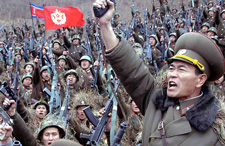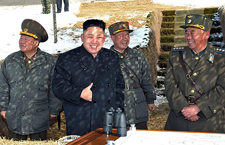North Korea Is Running Out of Threats
Daily News Article — Posted on March 28, 2013
(by Alastair Gale, The Wall Street Journal) – When North Korea tosses out another threat of violence against one of its neighbors or the U.S., it’s become routine to describe it as an escalation of Pyongyang’s rhetoric.
That description captures the fact that North Korea makes a lot of threats without following through. But is there a point where it’s not even appropriate to call new threats an escalation?
On Tuesday, North Korean state (government) media said that the country’s military command had ordered its rocket and artillery units to be on “highest alert” to strike bases on the U.S. mainland, Guam, Hawaii and other targets in the Pacific and South Korea.
Such threats, many analysts say, are little more than attempts by the North to draw the U.S. into dialogue with the strongest possible negotiating position, as well as a means to shore up domestic support.
On the surface, of course, they are alarming and they are usually accompanied by photos and video from the North of military drills for extra effect. (Some of these drills are unintentionally comical, however, as North Korea displays its aging military hardware.)
But the frequency of threats from Pyongyang since its Feb. 12 nuclear test has shown clearly that North Korea is simply running out of places and things to threaten, analysts say, undermining its own intentions. Rather than scare the U.S. and others into negotiations, such threats erode the North Korean regime’s credibility as it repeats old threats.
It’s already said a couple of times recently it might attack the U.S. mainland, including on March 5 when it said it was ready to hit the U.S. with a nuclear weapon.
On March 21, it said (not for the first time) it could attack U.S. bases in Guam and in Japan. And it’s had success in spooking the U.S. over a possible attack on Hawaii: in 2009, then-Defense Secretary Robert Gates said the U.S. had positioned extra missile defenses around the Pacific islands because of the threat from North Korea.
 Threats against South Korea, meanwhile, have become almost too frequent to catalog. Seoul said on Tuesday it hadn’t detected any unusual military activity in the North that might precede an attack.
Threats against South Korea, meanwhile, have become almost too frequent to catalog. Seoul said on Tuesday it hadn’t detected any unusual military activity in the North that might precede an attack.
As well as being a problem for North Korea, the recycling of old threats complicates assessing whether North Korea is actually signaling anything in all its tough talk.
Stephan Haggard, a North Korea watcher at the Peterson Institute for International Economics, calls the problem of Pyongyang’s routine belligerence the phenomenon of a low signal-to-noise ratio.
The concern is, of course, that North Korea has staged deadly attacks before. But these have usually not come with a warning. In November 2010, it shelled a South Korean island that it has been threatening again in recent weeks. And exactly three years ago Tuesday, it sank a South Korea warship, killing 46. There was no warning of either attack.
The threats against the U.S. are also hard to take seriously because hitting long-range targets is still widely believed to be beyond the current limits of North Korea’s missile technology. Putting a satellite into orbit on a long-range rocket as it did in December is a lot different from delivering a warhead to a desired location on such a rocket.
“North Korea has short and medium range missiles that could complicate a situation on the Korean peninsula (and perhaps reach Japan), but we have not seen any evidence that it has long-range missiles that could strike the continental U.S., Guam or Hawaii,” wrote James Hardy, Asia-Pacific editor at IHS Jane’s Defense Weekly, in a note to clients on Tuesday.
That’s unlikely to stop North Korea making fresh threats against such locations, just not new ones.
Copyright 2013 Dow Jones & Company, Inc. All Rights Reserved. Reprinted here for educational purposes only. Visit the website at wsj.com.
Questions
1. a) What is the capital of North Korea?
b) Who is the leader of North Korea?
2. Define the following words as used in the article:
escalation (para. 1)
rhetoric (para. 1)
undermine (para. 6)
erode (para. 6)
credibility (para. 6)
3. What threats has North Korea's government made against the U.S. and South Korea in recent months?
4. How does the media generally describe the increasing threats made by North Korea?
5. How do analysts view these same threats?
6. How are the recent threats of attacks different from previous real attacks North Korea has carried out?
7. a) In addition to not carrying out any of their threats, why is it hard for the U.S. to take North Korea seriously?
b) Does this fact cause you to believe that the U.S. should not prepare adequate defenses for a time when North Korea does acquire the actual capability to hit us in an attack? Explain your answer.
CHALLENGE QUESTION: Read the commentary by Rich Lowry on missile defense at: nationalreview.com/blogs/print/343314
Although North Korea has not carried out any of its recent threats, do you think Mr. Lowry is correct in saying we should have a good missile defense system rather than "simply trust that a lunatic regime running its country like a vast prison camp will rationally calculate its self-interest as we would hope [before attacking the U.S.]"
Explain your answer.
Background
ON THE NORTH KOREAN GOVERNMENT: (from the CIA World FactBook)
- An independent kingdom for much of its long history, Korea was occupied by Japan in 1905 following the Russo-Japanese War. Five years later, Japan formally annexed the entire peninsula. Following World War II, Korea was split with the northern half coming under Soviet-sponsored Communist domination.
- After failing in the Korean War (1950-53) to conquer the U.S.-backed South Korea (Republic of Korea – ROK) by force, North Korea (DPRK), under its founder President Kim Il Sung, adopted a policy of ostensible diplomatic and economic “self-reliance” as a check against excessive Soviet or Communist Chinese influence.
- North Korea demonized the U.S. as the ultimate threat to its social system through state-funded propaganda, and molded political, economic, and military policies around the core ideological objective of eventual unification of Korea under Pyongyang’s control.
- Kim Il Sung’s son, [dictator] Kim Jong Il, was officially designated as his father’s successor in 1980, assuming a growing political and managerial role until the elder Kim’s death in 1994.
- After decades of economic mismanagement and resource misallocation, North Korea since the mid-1990s has relied heavily on international aid to feed its population while continuing to expend resources to maintain an army of approximately 1 million. [Aid agencies estimate that a famine from 1995-1997 killed 2 million to 3 million North Koreans. Foreign food aid was given to North Korea, but the government distributed the majority of it to the military and party leaders.]
- [Kim Jong-il was an oppressive dictator who required that his people call him "Dear Leader"]
- Kim Jong Un was publicly unveiled as his father's successor in September 2010.
- Following Kim Jong Il's death in December 2011, the regime began to take actions to transfer power to Kim Jong Un and Jong Un has now assumed many his father's former titles and duties.
- North Korea's history of regional military provocations; proliferation of military-related items; WMD programs including tests of nuclear devices in 2006, 2009, and 2013 (long-range missile development; as well as its nuclear, chemical, and biological weapons programs) and massive conventional armed forces – are of major concern to the international community.

